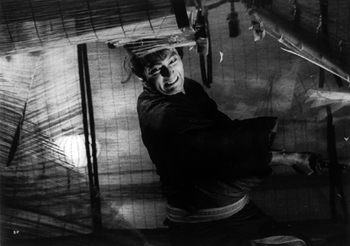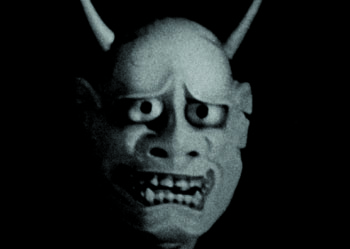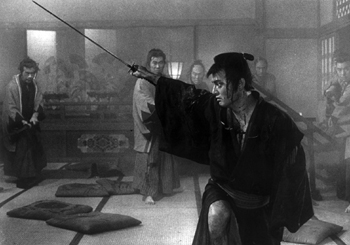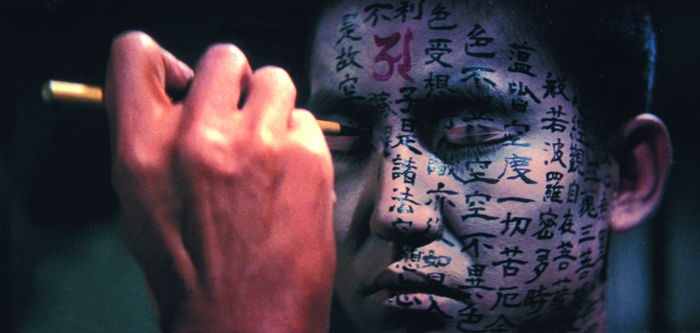 Katsuo Nakamura in a classic scene from Toho`s ghost film KWAIDAN, launching Japan Society`s Zen & Its Opposite monthly film series this Friday. Photo courtesy of Japan Society. © 1965 Toho Co., Ltd.
Katsuo Nakamura in a classic scene from Toho`s ghost film KWAIDAN, launching Japan Society`s Zen & Its Opposite monthly film series this Friday. Photo courtesy of Japan Society. © 1965 Toho Co., Ltd.Zen & Its Opposite: Essential (& Turbulent) Japanese Art House (October 15 2010-February 18 2011) Source: Japan Society Special Thanks to Kanako Shirasaki and Shannon Jowett
New York, NY – Japan Society`s Monthly Classics film series, Zen & Its Opposite: Essential (& Turbulent) Japanese Art House peers into the dark side of the classical repertoire of the late 1950s and 1960s, illuminating the paradoxical and little understood unity of Zen Buddhism and violence. Timed with The Sound of One Hand: Painting and Calligraphy by Zen Master Hakuin (October 1, 2010–January 9, 2011), Japan Society`s major exhibition of 18th century Zen paintings, Zen & Its Opposite launches Friday, October 15, with Masaki Kobayashi’s KWIDAN at 7:30 pm, screening another 4 films monthly through February 13, 2011. In Zen & Its Opposite, 5 master filmmakers offer the bloody and all-too-human spectacle of sin, folly and frailty, in unforgettable tales of crime and punishment, vengeful ghosts and delirious soldiers, mad samurai and deranged marauders, fire and brimstone, and spiritual darkness. The selection promises to satisfy the courteous viewer with an appetite for dark eroticism, macabre poetry and the exquisite monstrosity of the human heart, which will haunt long after viewing. In his book Zen at War, ordained Soto Zen priest Brian Daizen Victoria documented Japanese Buddhist support for violence and warfare, from 1868 until the end of World War II. He tracked down a surprising embracing of war-making to the intimate relation between Zen and samurai warrior culture.
Each film in Zen & Its Opposite illustrates one or several of the Six Planes of Existence—a Buddhist concept commonly referred to in Japan as "Six Paths" (rokudo) within "the realm of Birth and Death" (samsara). Kobayashi’s KWAIDAN personifies the Realm of Humans, a form of hell where tormented souls hover between good and evil, being and nothingness. Shindo’s ONIBABA bites from the Realm of the Animals, a condition of servitude in which one is governed by instinct, and in which one has no sense of morality and lives only for the present. Ichikawa’s FIRES ON THE PLAIN feeds from the Realm of the Hungry Ghosts, characterized by agonizing craving and eternal starvation. Nakagawa’s HELL burns from the Realm of the Beings in Hell, the lowest and worst of all realms, wracked by torture and violence. And Okamoto’s SWORD OF DOOM roars from the Realm of the Asuras—a realm of anger, jealousy, and constant war. Zen & Its Opposite: Essential (& Turbulent) Japanese Art House holds monthly screenings October 15, 2010-February 18, 2011. Japan Society is located at 333 East 47th Street between First and Second avenues (accessible by the 4/5/6 at 42nd Street-Grand Central Station or the E and V at Lexington Avenue and 53rd St.) Tickets are $12/$9 members, students & seniors. For reservations visit japansociety.org or call the box office at 212-715-1258. For further information call 212-832-1155 or visit the website. Japan Society Gallery presents The Sound of One Hand: Painting and Calligraphy by Zen Master Hakuin, October 1, 2010–January 9, 2011. Widely acknowledged as the leading Zen master of the last five centuries (it was he who first asked “What is the sound of one hand?”), Hakuin Ekaku (1685–1768) painting and calligraphy has influenced an entire. This first exhibition of Hakuin’s work in the West features 69 of his scrolls and 9 by his pupils that demonstrate bold brushwork, whimsical humor, and often unconventional approach. Organized in collaboration with New Orleans Museum of Art, and curated by Audrey Yoshiko Seo and Stephen Addiss. Hours: Tue-Thu, 11 am-6 pm; Fri, 11 am-9 pm; Sat and Sun, 11 am-5 pm. Admission: $12/$10 students and seniors/free Japan Society members and children under 16. Admission is free to all on Friday nights, 6-9 pm.
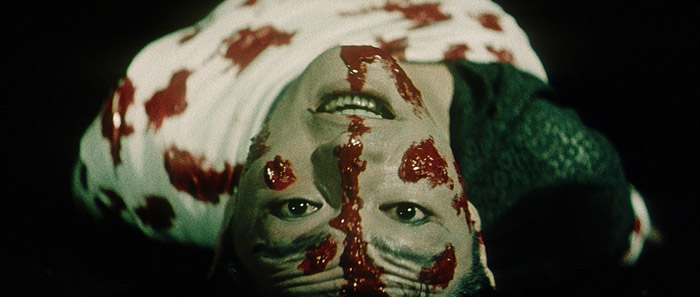 Shigeru Amachi in a bloody scene from HELL. Photo courtesy of Japan Society. © 1968 Kadokawa Pictures, Inc.
Shigeru Amachi in a bloody scene from HELL. Photo courtesy of Japan Society. © 1968 Kadokawa Pictures, Inc.Zen & Its Opposite Screening Schedule
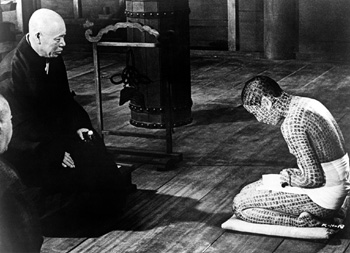 Takashi Shimura and Katsuo Nakamura in KWAIDAN. Photo courtesy of Japan Society. © 1965 Toho Co., Ltd.
Takashi Shimura and Katsuo Nakamura in KWAIDAN. Photo courtesy of Japan Society. © 1965 Toho Co., Ltd.KWAIDAN (??, Kaidan) Friday, October 15, 2010, at 7:30 pm 1965, 161 min., 35 mm, color, in Japanese with English subtitles. Directed by Masaki Kobayashi. With Michiyo Aratama, Misako Watanabe, Rentaro Mikuni, Tatsuya Nakadai, Keiko Kishi, Jun Hamamura. Print courtesy of Janus Films. Winner of the Special Jury Prize at Cannes,KWAIDAN features four nightmarish tales in which terror thrives and demons lurk. Adapted from traditional Japanese ghost stories, this lavish (one of the most expensive films of its time), widescreen production is a Masaki Kobayashi masterpiece. Painterly, haunting, hypnotic, KWAIDAN takes you to the far side of Zen and back.
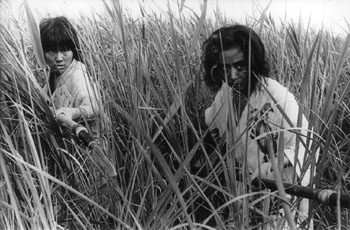 Jitsuko Yoshimura and Nobuko Otowa turn to murder in ONIBABA. Photo courtesy of Japan Society. © 1964 Toho Co., Ltd.
Jitsuko Yoshimura and Nobuko Otowa turn to murder in ONIBABA. Photo courtesy of Japan Society. © 1964 Toho Co., Ltd.ONIBABA (??) Friday, November 12, 2010, at 7:30 pm 1964, 103 min., 35 mm, B&W, in Japanese with English subtitles. Directed by Kaneto Shindo. With Nobuko Otowa, Jitsuko Yoshimura, Kei Sato, Jukichi Uno, Taiji Tonoyama. Print Courtesy of The Japan Foundation with permission from Janus Films. Nestled in a seemingly endless sea of swaying reeds during the war-ravaged days of 16th century Japan, a hard-bitten mother (Nobuko Otowa) and her young daughter-in-law (Jitsuko Yoshimura) lead the nefarious existence of marauders, murdering the stray soldiers and lost samurai who wander into the wilderness surrounding their hut, selling their war gear for rice, and dumping corpses in a deep, dark pit. When their rough and rugged neighbor (Kei Sato) returns from war, conflicting passions threaten to shatter the women’s sinister partnership, and soon the trio’s precarious cohabitation. Intensely erotic and steeped in Buddhist symbolism, ONIBABA is both a macabre parable on modern-day consumerism, and a lyrical morality play on the dark power of primal desires.
 Mickey Curtis and Eiji Funakoshi at war in FIRES ON THE PLAIN. Photo courtesy of Japan Society. © 1959 Kadokawa Pictures, Inc.
Mickey Curtis and Eiji Funakoshi at war in FIRES ON THE PLAIN. Photo courtesy of Japan Society. © 1959 Kadokawa Pictures, Inc.FIRES ON THE PLAIN (??, Nobi) Friday, December 10, 2010, at 7:30 pm 1959, 104 min., 35 mm, B&W, in Japanese with English subtitles. Directed by Kon Ichikawa. With Eiji Funakoshi, Osamu Takizawa, Mickey Curtis. Print Courtesy of Janus Films. 50 years before Clint Eastwood`s LETTERS FROM IWO JIMA, Ichikawa`s FIRES ON THE PLAIN denounced war with bone-hard forthrightness and barbaric grandeur. In the haunting and timeless tale of Private Tamura (Eiji Funakoshi), the sunken-eyed, tubercular straggler staggers through the hell-like lands of the Japanese-occupied Philippines in 1945. Focusing on the raw desperate drama of starving, barely surviving soldiers of the Imperial Army during the last days of World War II, the film shows war behind the cannons, when guns stop blazing and the battlefield leaves no triumphs or defeats. Winner of the Blue Ribbon Awards for Best Director and Best Cinematography, the Kinema Junpo Awards for Best Screenplay and Best Actor (Eiji Funakoshi) and the Mainichi Film Concours for Best Actor (Eiji Funakoshi). Dave Kehr said in the Chicago Reader, "No other film on the horrors of war has gone anywhere near as far," and Variety called it "one of the most searing comments on war yet made."
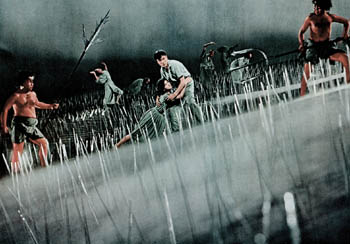 Utako Mitsuya and Shigeru Amachi are trapped in HELL. Photo courtesy of Japan Society. © 1968 Kadokawa Pictures, Inc.
Utako Mitsuya and Shigeru Amachi are trapped in HELL. Photo courtesy of Japan Society. © 1968 Kadokawa Pictures, Inc.HELL (??, Jigoku) Friday, January 21, 2011, at 7:30 pm 1960, 101 min., 35 mm, color, in Japanese with English subtitles. Directed by Nobuo Nakagawa. With Shigeru Amachi, Utako Mitsuya, Yoichi Numata, Torahiko Nakamura, Fumiko Miyata, Hiroshi Hayashi, Kimie Tokudaiji. Print Courtesy of The Japan Foundation with permission Janus Films. From the father of Japanese horror cinema, HELL explores the further regions of the human imagination and the untold oceans of darkness beyond, in a stunning and epic evocation of the underworld. Theology student Shiro Shimizu (Shigeru Amachi) has seen brighter days. After a hit-and-run accident that takes the life of a drunken yakuza, he tries to turn himself in, when a second car crash cuts his redemptive attempt short and kills his fiancée (Utako Mitsuya). His best friend (Yoichi Numata), who may very well be Shimizu`s malevolent doppelganger, gets him embroiled in a tangled web of deadly sin, eventually resulting in mass death. And this where the real psychedelic, psychotic and exotic fun begins. A jaw-dropping mix of surreal, expressionist horror and psychological drama, Nakagawa’s film still stands as one of the most innovative works of the genre ever.
SWORD OF DOOM (????, Daibosatsu Toge) Friday, February 18, 2011, at 7:30 pm 1966, 119 min., 35 mm, B&W, in Japanese with English subtitles. Directed by Kihachi Okamoto. With Tatsuya Nakadai, Toshiro Mifune, Michiyo Aratama, Yuzo Kayama, Yoko Naito, Kei Sato, Ko Nishimura, Ichiro Nakatani, Tadao Nakamaru. Print courtesy of Janus Films. Okamoto’s most celebrated film is samurai carnage cum historical fiction at its finest, starring Tatsuya Nakadai in a transfixing performance as a resplendent but ambiguous villain, and the incomparable Toshiro Mifune in a brief but pivotal role. This cult classic follows the downward spiral of a skilled but tormented swordsman (Nakadai) who kills without much regret, without mercy, and oftentimes, without purpose, during the turbulent final days of the shogunate rule in the early 1860s. From the opening frames to the famed apocalyptic finale, senseless slayings ensue along a long, twisted path of flagrant violations of all codes of honor. Pitch black, misanthropic and menacing, SWORD OF DOOM is a highly stylized and complex depiction of evil, visceral and blessed with the barbaric splendor of the best samurai epics.
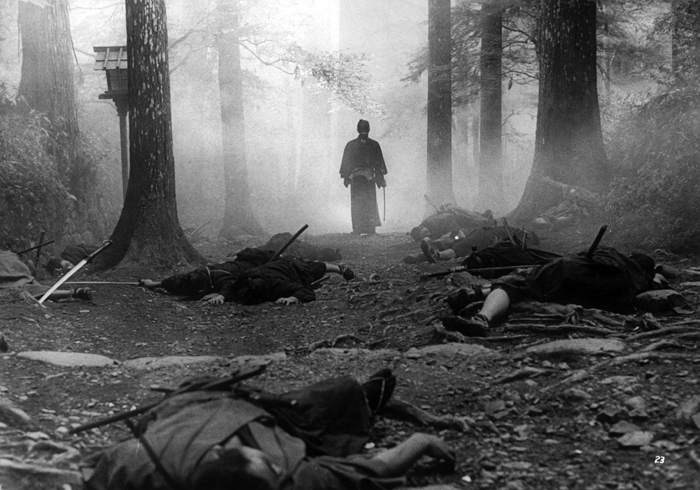 The haunting aftermath of battle in SWORD OF DOOM. Photo courtesy of Japan Society. © 1966 Toho Co., Ltd.
The haunting aftermath of battle in SWORD OF DOOM. Photo courtesy of Japan Society. © 1966 Toho Co., Ltd.About Japan Society
The Japan Society Film Program offers a diverse selection of Japanese films, from classics to contemporary independent productions. Its aim is to entertain, educate and support activities in the Society`s Arts & Culture programs. The Film Program has included retrospectives of great directors, thematic series and many U.S. premieres. Some original film series curated by Japan Society have traveled to other U.S. venues in tours organized by the Film Program. Established in 1907, Japan Society has evolved into North America`s major producer of high-quality content on Japan for an English-speaking audience. Presenting over 100 events annually through well established Corporate, Education, Film, Gallery, Language, Lectures, Performing Arts and Innovators Network programs, the Society is an internationally recognized nonprofit, nonpolitical organization that provides access to information on Japan, offers opportunities to experience Japanese culture, and fosters sustained and open dialogue on issues important to the U.S., Japan, and East Asia. Japan Society’s 2010-2011 Film Programs are generously supported by the Lila Wallace-Reader’s Digest Endowment Fund. Additional support is provided by The Globus Family, Yoshiko and Tim Schilt, David S. Howe, Dr. Tatsuji Namba, Elaine Sheng and Samuel Jamier, and with public funds from the New York State Council on the Arts, celebrating 50 years of building strong, creative communities in New York State’s 62 counties.


